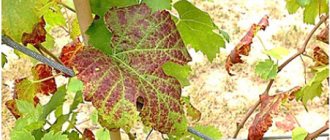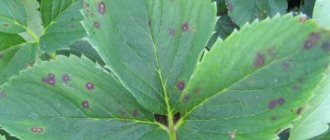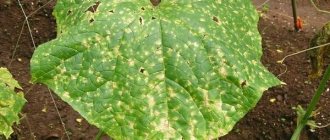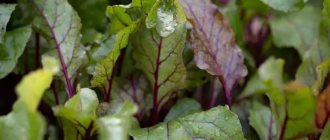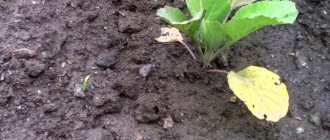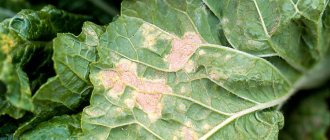Gardeners often encounter a problem - cabbage leaves turn red. They can be colored pink and even purple. It is important to understand why this happens and learn to determine the state of a culture by its appearance. Competence in these matters will help save the harvest.
Cabbage leaves turn red
What does the redness of cabbage leaves mean?
Cabbage leaves act as a kind of indicator, pointing gardeners to deficiencies in fertilizers and other care problems. Redness of the upper layers of the head of cabbage indicates a lack of nitrogen or phosphorus in the soil, and ignoring such signals leads to aggravation of the situation. Over time, the leaves acquire darker shades: red and dark purple.
In some cases, a simple change in weather conditions also leads to a change in color. In late autumn, this indicates the need for urgent harvesting, as cold weather is approaching.
Other problems with leaves on seedlings and mature plants
Quite often, diseases cause changes in the appearance of garden crops:
- cabbage leaves of any type become pronounced yellow and wither, and commercial-quality cabbage heads or heads are not formed if the plant is severely affected by cabbage clubroot;
- yellowing of cabbage is a very dangerous and fairly common disease that mainly affects weakened seedlings or young plants recently planted in a permanent place;
- damage by peronosporosis, or downy mildew, can be observed in any growing season, but most often progresses on cabbage seedlings and seeds, appearing in the form of yellowish, vague spots, as a result of which the plant turns yellow and dies.
The appearance of any spots requires spraying with 1% Bordeaux mixture and repeating the treatment after a week. Close attention should be paid to careful monitoring of the phytosanitary condition of the garden plot, including disinfection of the soil, removal of plant residues and varieties of plants. It is especially important to promptly destroy weeds belonging to the cruciferous family, represented by cress and shepherd's purse.
Reasons for color change
A pink leaf on a head of cabbage may appear due to:
- insufficient amount of fertilizer applied;
- recent rains or heavy watering, which carry some of the fertilizer deep into the ground;
- also, redness sometimes accompanies an attack by pests, but in this case there will be other signs: curling of leaves, the appearance of holes, and so on.
Important! Often, the wrong choice of cabbage variety leads to the manifestation of undesirable symptoms. Before purchasing, it is recommended to check with the seller whether the variety is suitable for a particular region.
Cabbage leaves curl or wilt
Leaves can curl for some reason. These include:
- Pest attack.
- Lack of water.
- Lack or excess of some elements.
If the plant lacks potassium. The leaves first acquire a brownish-yellow color, and then curl and die.
If there is not enough boron, the leaves turn white. Leaves may also curl if there is a lack of molybdenum.
Leaves may curl if not handled correctly. It is worth loosening the soil more often and watering the plant in the evenings. Watering should be done by pouring water into a hole or furrow. If the temperature outside is high, then sprinkling watering would be appropriate.
Cabbage is a very healthy vegetable; it can be included in many salads and other dishes.
Interesting. There is a well-known legend that tells that Alexander the Great forced his soldiers to eat cabbage before battles. He explained this by saying that by eating cabbage, a person becomes bolder, more confident, and fearless.
Associated symptoms
Depending on the cause of the color change, the accompanying symptoms also change:
- the lack of nitrogen causes the lower leaves of the head of cabbage to turn red;
- lack of phosphorus causes the formation of a pink tint to the top;
- if the outer leaves turn pink and become transparent, it means frost is rapidly approaching;
- redness in combination with strange dots, holes, wilting and curling of the leaf indicate the scourge of diseases or pests.
See also
The best way to treat Chinese cabbage to combat pests and diseases
Read
The leaves of the plant have white or black spots
The cause of white spots on the leaves is a lack of magnesium. They become like marble, then begin to dry out. In this case, add lime to the soil and feed the cabbage with solutions of potassium magnesium and magnesium sulfate.
If you see slightly depressed gray or black spots with a diameter of 1 - 5 mm on the leaves, this means that there is an excess of nitrogen and a lack of potassium in the soil.
If you find whitish oil spots, this means that the crop is affected by linen. To eliminate the disease, spray the plants with preparations that contain copper.
If cabbage seedlings are covered with grayish fluffy mold and have small dark spots, this is gray cabbage rot.
See also
Diseases and pests of white cabbage and their controlRead
What danger does cabbage planting pose?
The main danger that lies in the redness of cabbage leaves is a decrease in healthy yield. The lack of necessary fertilizers in the soil leads to slower growth of the head of cabbage, changes in color and taste.
Due to the lack of phosphorus, the root part begins to rot, causing the plants to disappear.
Redness caused by pest invasion causes a decrease in the aesthetic value of cabbage, reduces or completely destroys the seasonal harvest and makes the vegetable dangerous for consumption.
Why cabbage leaves turn red - the main reasons
Having noticed red spots on cabbage leaves , you should immediately carefully visually inspect all the plants. In the absence of pests and traces of characteristic diseases, most often the cause of this phenomenon is two main factors.
Lack of micro- or macroelements
Cabbage requires sufficient nutrients to form dense and juicy forks. A pronounced deficiency of any micro- and macroelements negatively affects the development of the plant.
Noticeable redness of the leaf blades is evidence of a lack of phosphorus. If, despite the general green color of the plant, redness clearly spreads along the lower leaf blades of the cabbage, then we can conclude that there is not enough nitrogen in the soil .
Cabbage with reddened leaves
Adverse weather conditions
Sometimes, even with timely application of the required fertilizer complex, noticeable redness of the cabbage heads . In such a situation, in the absence of harmful insects or diseases, cold weather is most often the provoking factor. With a sharp drop in temperature, the roots slow down their activity, so less necessary nutritional compounds reach the above-ground part.
Long rainfalls cause a sharp decrease in the supply of necessary nutrition to plants. With precipitation, a significant part of the chemical compounds important for the development of the crop, especially phosphorus, is washed out from the upper soil layers. Considering that the root system of cabbage is located relatively shallow, then, accordingly, the forks do not receive the required amount of substances necessary for their normal formation. This is expressed by redness on the leaves.
Redness always starts on the back of the cabbage leaf
Advice! If the cabbage suddenly turns red during the autumn season, then you should think about immediate harvesting. Delay is fraught with partial or complete loss of the harvest.
What to do?
As soon as the first undesirable signs of discoloration appear, and there is no smell of frost, the main question that arises for the gardener is what to do? There are several most effective methods, which vary depending on the age of the seedlings (seedlings or mature bushes).
Important! Young bushes have reduced immunity and may not be able to cope with pests. Also, if you notice it too late, applying fertilizers will not produce results. Therefore, in order not to prevent the disease, it is recommended to pay due attention to prevention.
Saving seedlings
To avoid reddening of the leaves and other characteristic symptoms, it is recommended:
- plant young plants in open ground after about a month and a half, when the first 3-5 leaves appear;
- it is necessary to sow seeds in already fertilized soil, with a high content of nitrogen fertilizers, and then regularly add additives to the soil;
- It is also necessary to protect seedlings from possible temperature changes.
When growing seedlings, it is recommended not to chase their growth. The height of the seedling is inversely proportional to the strength of the root system. Small bushes have strong roots and are subsequently distinguished by proper development and stable immunity.
We treat adult bushes
Reddening of the leaves of mature cabbage is most often easily eliminated by applying appropriate fertilizers. Suitable for this:
- ammonium nitrate;
- urea;
- ammonia solution;
- lime;
- bird droppings.
However, it is important to develop a special feeding regimen and not to overdo it. The plant will also let you know about the excess of the above-mentioned substances in the soil. In case of excess, not the entire leaf changes color, but becomes covered with characteristic spots of yellow, white or black.
See also
Description of Kharkov winter white cabbage, cultivation and care
Read
Plant Rescue Methods
Having information about what unfavorable factors provoke the appearance of redness on cabbage leaves helps you quickly take the necessary measures.
Having determined that the crop lacks nitrogen, add urea or ammonium nitrate (10 grams per square meter). You can dilute liquid bird droppings in a ratio of 1:20 in settled water. 500 ml of the prepared nutrient solution is poured under each plant. It is recommended not to feed cabbage with nitrogen in the second half of summer.
This is what a healthy head of white cabbage should look like
If plants require phosphorus, then superphosphate is scattered over the soil surface. It is calculated that for every square meter 2 tbsp is required. spoons of this fertilizer. Then water the area with a watering can. You can use potassium monophosphate for quick feeding, which will require half the volume.
When a sharp cold snap occurs in the summer, it is advisable to cover the plantings with cabbage with film.
Affected cabbage leaves
In order to prevent reddening of cabbage leaves, varieties are selected that are recommended for cultivation in a particular region. This will allow them not to suffer in the event of an unexpected cold snap. Seedlings should be hardened off so that they can quickly adapt to open ground conditions. It is planted in soil that is provided with the required amount of nitrogen and phosphorus fertilizers.
Author of the article: Kamenkov Igor Dmitrievich
Tags: cabbage, vegetable garden
- Related Posts
- How to get rid of ants on your property using folk remedies
- How to get rid of aphids in the garden using folk remedies once and for all
- Wasps in the country house, garden, vegetable garden? How to get rid of them once and for all
« Previous entry
Preventing cabbage leaf discoloration
In order to prevent cabbage pest control, it is recommended to spray the bushes with a solution of Bordeaux mixture.
The product also has disinfecting properties and prevents the emergence and development of traditional diseases.
Fertilizing should also be done regularly. It is recommended to pay particular attention to the period after precipitation. Rains carry fertilizers from the surface with them deeper, where cabbage roots cannot reach.
How to deal with cabbage pests (video)
Good results are obtained by planting dill, carrots, onions or nasturtiums on cabbage beds. During the season, it is advisable to sprinkle the aboveground part of the garden crop and the soil around it several times with ordinary tooth powder or wood ash, and also treat the plants with an infusion based on tomato tops or celandine. Strict and competent adherence to basic agrotechnical practices at all stages of plant growth and development will minimize the risk of damage to cabbage plantings by pests and will reduce the likelihood of disease affecting the garden crop.
Answers to frequently asked questions
It would seem that growing and maintaining cauliflower is not difficult, but gardeners still have questions regarding tying heads.
Why do cauliflowers have small heads?
The reason in this case may be the same as in the complete absence of the ovary. Basically, underdeveloped heads are obtained due to poor quality of seedlings. Negative factors may include unsuitable soil, lack of moisture and fertilizers. At the last stages of the growing season, the plants most likely did not have enough microelements, namely boron and molybdenum.
Why do cauliflower inflorescences stretch out?
Sometimes cauliflower, instead of producing dense heads, forms spreading bouquets of inflorescences. The cause of this disease can be several factors: lack of microelements, improper application of fertilizers.
If cauliflower blooms, what should you do?
Sometimes cauliflower goes into color. This happens due to inappropriate care or inappropriate weather. Instead of a full head of cabbage, a thin sprout with a loose umbrella is formed. In this case, the top of the plant is cut off along with the inflorescences and the failed head, leaving a stalk 15 cm long.
Soon the cabbage will produce new shoots from the lower buds. Of these, a couple of the strongest are left, the rest will need to be removed. After this, the vegetable is provided with favorable conditions by regular watering and fertilizing. In this case, the harvest will be later, but it’s better than nothing. When the heat subsides in August, the cabbage will form new dense heads of cabbage.
The leaves changed color and holes appeared in them.
Why did the cabbage leaves change color and get eaten?
This occurs due to pest attacks:
- Damage by cabbage spring fly. Cabbage fly larvae are small, inconspicuous worms that feed on roots. To eliminate the pest, solutions of Rovikurt (0.1%), Tolkord (0.1%), and Anometrine (0.6%) are used.
- The appearance of cabbage scoop. This is a small brownish-gray butterfly. If you notice insects, then you need to spray the cabbage with the following preparations: Ambush, Tsimbush, Belofos, Cyanox.
- Aphid attack. Insects can eat most of the plant very quickly. For prevention, it is necessary to properly water the crop. If the aphid does attack, then the plants are treated with Tolkodorm, Ambush, Corsair, Rovikurt, Antio.
- Damage to cabbage leaf beetle. What to do if you see a leaf beetle? Spray the plantings (0.15%) with Actellik.
The problem can also arise due to a variety of diseases:
- leaves turn yellow, wither, and do not form heads if affected by clubroot;
- peronosporosis (downy mildew) - yellowish spots appear during the disease, then the plant dies.
If any spotting occurs, spray the plants with 1% Bordeaux mixture, then repeat spraying after a week.
Preventative work
Trouble can be easily avoided if you properly care for the vegetable when growing cabbage. Please comply with the requirements below:
- Do not over-moisten or over-dry the soil. You need to water vegetables 1-2 times a week and in the evening. In summer, during periods of drought, increase watering, but not more than once every 2 days, this will be quite enough. In order to retain moisture in the ground longer, mulch it with a peat layer of 5-7 cm;
- use fertilizers. Even if the soil on the site is fertile, with each watering the level of nutrients in it is gradually depleted, so a lack of microelements occurs. To replenish them, carry out 3 feedings per season. The composition of the first should mainly include nitrogen components (ammophoska, saltpeter). The second feeding is best done with organic matter (chicken, mullein, ash). For the third time, feed the culture with potassium sulfate with the addition of superphosphate (one tablespoon of substances per 1 liter of water);
- treat for pests. There is no need to wait until aphids appear near the plantings. 1-2 treatments against it in spring and summer will reliably protect the crop. To prepare solutions, gardeners use tomato tops, tobacco dust, onion peels, and garlic. Spray the planting mixture and leave until completely dry. This method works effectively not only against aphids, but also protects cabbage from slugs, fleas and other pests.
On a note!
Plant garlic, onions, calendula, mint, and lemon balm next to the cabbage heads. Because of the pungent aroma, insects will not attack vegetables.
Curling leaves on cabbage is a common problem faced not only by novice gardeners, but also by experienced gardeners. With competent actions on the part of the gardener, there will be no harm to the plantings, and the heads of cabbage will be smooth and beautiful. Care for cabbage correctly, and then the harvest will be healthy, and its quantity will undoubtedly please you.
All your articles will be on this page.
Cabbage seedlings “fall” - why do plants disappear?
If you grow seedlings according to all the rules and understand for sure that they have not outgrown, but young plants still “fall”, you need to check whether your cabbage seedlings have contracted an unpleasant fungal disease, blackleg.
Black leg in cabbage seedlings is the popular name for rot of the root collar of seedlings. In infected young plants, the base of the stem darkens and softens, and then the seedlings literally “fall”, having lost their support.
The reasons for the formation of blackleg lie in the same incorrect agricultural technology:
- contaminated soil,
- thickened sowing,
- excessive watering,
- lack of fresh air,
- excess humidity and heat,
- sudden changes in temperature.
Measures to combat blackleg, as follows from the above, primarily consist of disease prevention - purchasing healthy seeds, disinfecting the soil before planting, and observing all conditions for growing seedlings.
If the fungus has already infected most of the seedlings, remove and destroy all diseased plants along with the soil, and pick up healthy seedlings into separate containers with disinfected soil, place them in a warm place, shade them from sunlight, and after the soil has dried, water them with a solution of any fungicide (Fitosporin, Baktofit, etc.).
- Black leg in seedlings - how to fight (preparations and folk remedies)
Don’t know how to save seedlings from the insidious black leg? Read our article!
Step-by-step instructions: what to do if the leaves of the zygocactus turn red?
First of all, as mentioned above, the plant needs proper care. Usually this is enough for the leaves to return to their original green color.
If the cause of reddening of the leaves is waterlogging, then most likely the roots of the flower have been affected by rot. How to save a plant?
Algorithm of actions:
- carefully inspect the flower for pests; if there are any, then the above-ground part of the plant must be treated with special preparations;
- prepare new soil, an antiseptic composition and sharp scissors, preferably a small garden pruner;
- remove the plant from the pot, carefully free the roots from the ground;
- rinse the root system under warm running water;
- inspect for rotting;
- remove all damaged fragments with a sterile instrument, capturing 1-3 cm of healthy tissue;
- treat all cuts with an antiseptic - this can be crushed activated carbon, ash or simple brilliant green;
- leave the plant for 2-4 hours to air dry;
- Place a layer of drainage on the bottom of the pot - perlite, fine gravel;
- cover the drainage with soil;
- Place the roots in a pot and cover with soil.
Immediately after transplantation, do not water the plant, leaving it alone in a shaded place for 2-3 days.
Causes of curled leaves
Most often, the leaves curl suddenly, within a couple of days. If you see this happen, carefully examine the vegetable for other signs of damage. It is possible that you will see larvae or living insects right on the cabbage leaves, and the reason will immediately become clear. In other cases, it is not easy to immediately recognize the causes of twisting. There can be many of them: weather conditions, improper care or poor composition of the soil at the dacha.
High air temperature
If the region is incredibly hot, about 30 degrees, and there has been no rain for a long time, then the cabbage leaves curl inward. This is a vegetable’s protective reaction to overheating. When the air temperature returns to normal (drops to 23-24 degrees), the cabbage will take on its normal appearance. Gardeners recommend spraying plantings with mineral fertilizers or a weak solution of potassium permanganate during hot periods. They will help the crop better withstand the heat.
Aphid attack
One of the most common reasons why curling occurs is the attack of vegetables by aphids. Small flying midges cause enormous damage to crops, and their colonies increase so rapidly that in a few days the insect will destroy the entire future harvest. The aphid feeds on cabbage juice: through a small proboscis it bites through the greens and absorbs the liquid, which causes the leaf to curl. Then white spots appear on the leaf surface, and the greenery itself gradually dies. The pest can be exterminated using insecticides and folk remedies.
Whitefly attack
Another dangerous pest for cabbage is the whitefly. She, like aphids, feeds on plant sap, so the crop becomes deformed due to lack of moisture. The whitefly must be destroyed as soon as it appears on the plantings, and chemicals and folk methods will help with this. The result of the treatment will be the first time, and after 2-3 procedures the insect will completely disappear from the area.
Excess of mineral fertilizers
If the cabbage leaves of the seedlings curl into rings and become very brittle and dark, this indicates an excess of nitrogen in the soil. Due to its large amount, other substances cease to nourish the vegetable, so their deficiency occurs. In particular, nitrogen blocks phosphorus. The situation can be corrected if you feed the crop during the active growth of green mass with potassium-phosphorus fertilizers. Within just a few waterings the plants will return to normal.
Lack of other microelements
Another common reason why leaves curl and turn lighter lies in the lack of microelements in the soil. Lack of potassium, zinc, phosphorus, copper and boron causes deformation and even discoloration. For example, due to a lack of copper in the soil, the color of cabbage may change to red or purple, and the young leaves are the first to be damaged. If you do not add the substances in a timely manner, the vegetable may die. To prevent deficiency of substances, use various fertilizers with a complex composition when growing cabbage crops.
Attention!
The composition of fertilizers should include sulfur and copper. When combined together, they enhance each other’s effects and replenish the deficiency well.
Lack or excess moisture
In hot weather, moisture does not stay in the soil for long, so the leaves bend toward the ground and become curled. In the future, the head of cabbage will take a very long time to form, and its quality will be low. If the cabbage is over-watered, the excess liquid causes the leaves to become brittle and quickly break. Overmoistening leads to the fact that the heads of cabbage crack and are not suitable for long-term storage. Observe the frequency of watering, this is the only way you can protect vegetables from cracking and curling.
Lack or excess moisture
A lack of moisture is observed in cases where high air temperatures and low air humidity remain outside for a long time. Because of this, the leaves lose their elasticity, curl into a tube and fall down. How to water cabbage correctly to prevent problems with the harvest:
- watering is carried out up to two times a week;
- Irrigation should be carried out only in the evening;
- in the summer season, cabbage is watered every two days;
- To preserve liquid, the soil is mulched with a 5 cm layer of peat.
Cabbage especially needs abundant irrigation when the heads of cabbage begin to set and grow.
During this period, it is extremely important to monitor the soil moisture regime and prevent the substrate from drying out. Overmoistening, that is, excess moisture in the soil, in cauliflower leads to the fact that the heads of cabbage crack and the fruits can no longer be stored.

